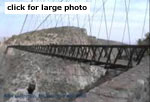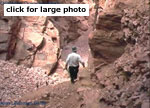|
||||
Mineral Specimen Collecting:
|
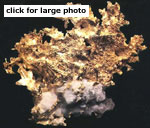 |
Crystalline native
gold on quartz matrix. Eagles Nest Mine, California, USA. 8 x 7 cm. Museum of Geology, Lausanne, Switzerland. Photo Stefan Ansermet. |
Breckenridge, Colorado was settled in 1859 as a gold and silver mining town. A collection of the distinctive gold specimens mined over the years can now be seen at the Denver museum, including Tom's Baby, an eight-pound nugget of crystallized gold unearthed in Breckenridge in 1887.
Gold specimens in nugget form are also collector's favourites, and are often found in alluvial gold fields using metal detectors.
Gold, as a noble metal, is relatively chemically inactive. However it does occur rarely in nature in the form of minerals, combined with other elements such as silver, copper, tellurium, lead, and antinomy.
Cripple Creek, Colorado is another famous gold mining district, where gold was found in the form of Tellurides. Here the author went on an underground tour at the Mollie Kathleen gold mine.
Exploration and discovery of gold in the 19 th century was a chance affair and usually relied on finding visual gold, either in matrix in an outcrop, or in nugget form, or by gold panning in streams and rivers. Any rich discovery was often followed by a gold rush.
South Africa: The first gold rush started at Pilgrims Rest, which was declared a gold field in 1873; soon after digger Alec "Wheelbarrow" Patterson had found gold deposits in Pilgrim's Creek. The Valley proved to be rich in gold and by the end of the year, there where about 1500 diggers working in the area, living in tents in squalid conditions. (His nickname arose from the fact that he arrived at Pilgrims Creek with all his worldly possessions carried in a wheelbarrow.) President Burgers, on hearing of the gold strike, hastily had the Transvaal Mining Laws drafted, (none having existed until then), after a quick study of the Mining Laws of Australia, New Zealand, and California. He then visited the mining camp with some aides, and after some negotiations with the miners and amendments, the new laws were put into place.
Access in those days was via Mozambique crossing what is now the Kruger Park. A visit to the cemetery testifies to the low life expectation of the miners. Many, who escaped the dangers of lions and other predators succumbed to malaria or other tropical diseases.
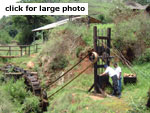 In 2001
the author panned gold during a visit to Pilgrims Rest, and was
delighted to see a few tiny flakes at the bottom of the pan,
nestling with some other black heavy minerals. This photo shows
the author inspecting some antique mining equipment at Pilgrims
Rest.
In 2001
the author panned gold during a visit to Pilgrims Rest, and was
delighted to see a few tiny flakes at the bottom of the pan,
nestling with some other black heavy minerals. This photo shows
the author inspecting some antique mining equipment at Pilgrims
Rest.
South Africa still claims to be the largest gold producer, with 40% of the world's known reserves, and some of the richest and deepest gold mines.
North America has experienced many gold rushes, including California from 1848 to 1864, and the Klondike in 1896 but at Nome the gold was literally found on the beach. "The coast was icebound for the season, but gold seekers began descending on the tent town in the spring of 1899. During that summer alone, more than two million dollars' worth of gold was taken from the beaches of the booming city of Nome."
It is interesting to note that, despite the short duration of these historical gold rushes, several new gold mines are planned to open in Alaska and British Columbia over the next few years.
Despite the large quantities of gold mined during these gold rushes, few specimens from that era remain. In fact the majority of gold specimens in collections today, have been mined in the last 25 years, either in specimen mines, or commercial mines with a policy of saving mineral specimens, and in smaller quantities from amateur gold panning and metal detecting.
It is to be hoped that new gold specimens for the collectors market will become available from some of these new mining projects.
This essay makes no attempt to cover all the best localities, (historically or more recent), for gold specimens, but for those interested in an in-depth coverage Robert B. Cook's article in Rocks & Minerals Jan/Feb 2004 is highly recommended. (see link in Further Reading below)
Gold exploration has changed radically from those bygone days. Geophysical and geochemical surveys are now used to identify drill targets. Drill programs are used to create Feasibility Studies, followed by permitting, construction and production, normally a 7 year process. The cost of building a new large gold mine runs into several hundred million us$.
The days of the Gold Rushes
have gone, but Gold fever is now still occasionally seen on
the stock markets, when gold drilling results are reported by
a mining or exploration company!
One famous mine currently producing gold specimens for collectors
is the Red Lake mine.
David Joyce sells the specimens on behalf of Goldcorp, and kindly agreed for his essay to be reproduced here (an abridged version of the original which appeared in Rocks and Minerals).
The Red Lake Mine: The Richest Gold Mine in the World
David K. Joyce
Box 95551, Newmarket, Ontario
Canada L3Y 8J8
dkjoyce@attcanada.ca
Stephen McGibbon
Manager Exploration, Goldcorp Inc.
Balmertown, Ontario, Canada P0V 1C0
smcgibbon@goldcorp.com
Introduction
 In
1989, Goldcorp Inc. took over Dickenson Mines Ltd, a venerable
gold mining company that, since 1948, had operated the Arthur
White mine in the Red Lake mining camp, located north of Lake
Superior, near the Ontario Manitoba border. Robert McEwen, chairman
of Goldcorp Inc felt that the adage, "the best place to
look for a new orebody is near an old mine" had some credence.
Was he right!!? Goldcorp initiated an exploration program while
the old mine rolled along as a break-even or money losing gold
mining operation. During early 1995 while testing Goldcorp's
geological theory, diamond drillers cut across a very high-grade
body of mineralization that was soon to become the fabulous "High-Grade
Zone (HGZ)". Diamond drilling continued and the HGZ has
proven (at time of writing) to contain more than 1.96 million
tons of high-grade ore containing 4.6 million ounces of gold.
That is an average grade of 2.35 troy ounces per ton! Most gold
mines in the world average well under 0.5 troy ounces per ton.
So prolific was the change in fortunes of the mine, that the
Arthur White mine was re-named the Red Lake mine.
In
1989, Goldcorp Inc. took over Dickenson Mines Ltd, a venerable
gold mining company that, since 1948, had operated the Arthur
White mine in the Red Lake mining camp, located north of Lake
Superior, near the Ontario Manitoba border. Robert McEwen, chairman
of Goldcorp Inc felt that the adage, "the best place to
look for a new orebody is near an old mine" had some credence.
Was he right!!? Goldcorp initiated an exploration program while
the old mine rolled along as a break-even or money losing gold
mining operation. During early 1995 while testing Goldcorp's
geological theory, diamond drillers cut across a very high-grade
body of mineralization that was soon to become the fabulous "High-Grade
Zone (HGZ)". Diamond drilling continued and the HGZ has
proven (at time of writing) to contain more than 1.96 million
tons of high-grade ore containing 4.6 million ounces of gold.
That is an average grade of 2.35 troy ounces per ton! Most gold
mines in the world average well under 0.5 troy ounces per ton.
So prolific was the change in fortunes of the mine, that the
Arthur White mine was re-named the Red Lake mine.
There are other orebodies in the world that, being larger contain more troy ounces of gold. However, to our knowledge, there are no other gold mines that contain the average grade of ore that the Red Lake Mine does. These sorts of orebodies come along only once every several decades, or so.
The HGZ changed the economics of the old mine so much that Goldcorp Inc. decided to build a brand new mine around the new orebody in order to optimize its extraction. A new milling complex and offices were built along with a camp to house contract workers. The only significant parts of the original mine that remained in use were the headframe and shaft needed to access the orebody. Recently, however, Goldcorp has decided to also replace the old shaft and winze with a brand new 7,500 foot single lift, vertical shaft in an effort to speed up the mining of the new orebody and to improve the overall efficiency of the mine.
The impact of the discovery of the new orebody on Goldcorp, the Red Lake mine and the surrounding area have been dramatic. With millions of dollars surging into the local economy from the Red Lake Mine and the exploration efforts of other companies hoping to duplicate the feat, the Red Lake area has experienced a surge of prosperity and confidence not felt since the hey-days of gold mine discoveries in the 1940s and 1950s. Now, Goldcorp is cash rich with no debt, and is one of the most profitable mining companies in the world.
It became apparent early in the exploration of the orebody that visible native gold would often be encountered. The senior management of Goldorp decided, to their credit, that if specimen-grade native gold was encountered, some of it should be preserved as specimens to serve as a legacy of Goldcorp, the Red Lake mine and the fantastic orebody that produced them. David K. Joyce was retained to prepare specimens, on site and, then, to market and sell the specimens. Since production commenced, hundreds of beautiful, rich native gold specimens have been recovered and sold to museums, shareholders, collectors and universities around the world.
Many mines have zones of high-grade ore that are very profitable to mine. Few have had a zone like the High Grade Zone, however, which is still open at depth and, although smaller in width at depth, appears to be increasing in grade.
The property on which the Red Lake mine is located comprises fifty-eight patented mineral claims held by Goldcorp covering approximately 2,348 acres, which, on the west side, share a common boundary with Placer Dome Ltd.'s Campbell Mine. Goldcorp also holds mineral claims covering approximately 56,125 additional acres of prospective mineral ground in the Red Lake area. Access to the mine is by road and by air, with the closest major cities being Winnipeg Manitoba and Thunder Bay, Ontario.
The Red Lake mine is currently operating at a rate of 550 tons per day of ore. Mining is accomplished using, mostly, a mechanized cut and fill mining method utilizing jumbo drills and 5 cubic yard scoop trams. At the present time, ore is being mined between the 31 and 37 levels, at a depth of about 4,000 and 5,500 feet below surface. At the time of writing, ore averaging about 2.28 troy ounces of gold per ton is being hoisted to surface. When the new shaft is finished in 2006, production will increase to 1000 tons per day.
The mill at the Red Lake mine uses several techniques to separate gold from the waste rock. One circuit uses centrifugal force and gravity, employing Knelson concentrators and a Diester jig table, respectively to separate coarse gold from the rock. Another circuit employs flotation to float gold rich sulphides to produce a gold-rich sulphide concentrate. Third, a carbon-in-pulp circuit is used to capture the fine gold that is not tied up in sulphides. Much of the concentrates produced by the above methods contain bits of rock and other impurities. The concentrates are refined by smelting where they are melted and the impurities are removed as a slag. The finished products at the mine are dore bars, which are poured molten into molds, after the refining is complete. Dore is a mixture of gold and silver with some other minor impurities and, at the Red Lake mine, contain, on average, about 87 percent gold and 13 percent silver are poured on-site. The dore bars are sold to refineries who further purify the gold and sell it to end-users, financial institutions and investors. Goldcorp actually does not sell but retains a certain percentage of its gold, in the belief that gold is undervalued. Currently, Goldcorp owns more gold bullion than many governments of the world!
Security is very tight at the Red Lake Mine. All people and vehicles enter and leave the mine through a single gate. Security guards are diligent in searching all belongings and vehicles, to ensure that gold is not smuggled out of the mine. All people leaving the mine are required to undergo a search, similar to those undertaken at airports, with subjects selected at random. All briefcases and luggage leaving the mine are searched.
Regional Geology
Ontario and Quebec occupy much of the "Canadian Shield" a prolific, Precambrian age geological formation and the home of many of the world's greatest mines, past and present. There are many "belts" of greenstone (highly contorted, Pre-cambrian volcanics and sediments) throughout the Canadian Shield. These greenstone belts have been the geological environments where gold deposits are found such as: Campbell, Hollinger, Dome, Sigma, Kerr Addison, Lakeshore, Macassa, McIntyre, Hemlo, Doyon, Bousquet, Malartic, Camflo, etc., all multi-million ounce producers. Goldcorp's Red Lake mine lies in the eastern part of the Red Lake Greenstone Belt. This belt is made up of an assemblage of ultramafic, mafic and felsic volcanic rocks with a sedimentary sequence. These rocks are cut by a number of felsic and mafic dykes.
Styles of Gold Emplacement
The two major types of gold mineralization consist of high-grade quartz-carbonate-sulphide mineralization grading 2.35 troy ounces of gold per ton ("opt") and the lower grade sulphide zones grading 0.37 opt. To reflect that variation, the zones have been grouped into two categories, the high-grade zones (the "High-Grade Zone") and the sulphide zones (the "Sulphide Zone").
Mineralogy
Gold Gold is the principal ore mineral at the Red Lake mine and the mineral that is the most interesting to collectors. The gold in the High Grade Zone was largely emplaced as a result of gold-rich, siliceous replacement of carbonate veins and, as well, by injection into volcanic rocks. Large masses of native gold up to many hundreds of troy ounces have been encountered during mining. On occasion, knobs or masses of native gold can be seen protruding from stope backs or walls. These are rich sights to behold! It is from those places, that the most impressive specimens of native gold have been recovered.
There appears to have been some subsequent remobilization of native gold into fractures in quartz and carbonates (calcite, ferroan dolomite) and into intensely altered volcanics. Arguably, the best specimens of native gold result when the gold has formed as veinlets in these fractures. The gold forms more coherent, solid veinlets or "leaves"in the calcite and quartz than it does in the altered rocks. These veinlets, when exposed, become the "leaves" and "plates" that we see in the specimens from the Red Lake Mine. A large percentage of the native gold at the mine occurs only as fine fracture fillings or coarse masses in altered volcanic rock that are not suitable as specimens other than as examples of fantastic high grade ore!!
On occasion, masses of very coarse gold are encountered in dark gray-black quartz. This type of high-grade is slabbed and sold to lapidaries for use in jewellery. Geologists and others interested in ore textures find the slabbed high-grade specimens interesting, as well.
Berthierite and Stibnite The only other species that occur at the mine that are of interest to collectors are stibnite and berthierite. Rich, high grade-gold is, on occasion, associated with metallic black masses of coarse stibnite and berthierite. Crystals of these minerals have not been observed but their association with coarse gold makes for interesting specimens.
Specimen Recovery
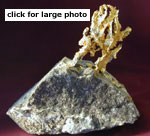 |
This specimen
from the Red Lake Mine shows a unique burst of native gold protruding
from the top of the matrix of altered volcanic rock. 8.5 cm tall. D.K. Joyce specimen and photo. |
Company geologists regularly visit stopes and development headings to gather samples and map local geology and to give direction to miners. The geologists are accustomed to seeing native gold in the HGZ but are constantly on the lookout for the extra-high-grade areas that are occasionally encountered. These extra-high-grade areas are erratically distributed throughout the mine and often run locally in the many hundreds of ounces per ton over distances of tens of feet. These super-rich zones are often the sources of specimen-grade-high-grade that can be prepared to produce the beautiful gold specimens for which the Red Lake Mine is becoming famous. When geologists encounter the super-high-grade areas, they collect any likely looking gold-bearing ore and place it in locked, metal boxes. These boxes are moved to the shaft, taken to surface and stored in the vault.
David K. Joyce, periodically visits the mine and works on each individual piece of high grade to, if possible, better expose the beautiful gold leaves, plates and other interesting formations that are enclosed in the matrix rock and vein material. He "reads" the grain of the rock and the directions of gold emplacement and then with a host of tools breaks, chips and chisels away the minerals that cover the gold, in an effort to produce aesthetic specimens that are coveted by collectors, investors and museums around the world. The vault can be a spectacular sight when full of native gold-bearing-hi-grade ore and finished specimens!
Interestingly, Goldcorp has retained one specimen in particular which consists of a thick vein of nearly solid gold traversing altered volcanic rock. The specimen is estimated to contain 298 troy ounces of gold! Goldcorp often brings this large specimen to trade shows to tantalize people.
Conclusions
The Red Lake Mine is, based on the very high average grade of current ore and life-of-mine ore reserves, to our knowledge, the richest gold mine in the world. To its credit, Goldcorp has decided to recover and market beautiful specimens of high grade ore to be sold to museums and collectors around the world, specimens that will serve as a legacy of this orebody. They will delight collectors, prospectors, museum visitors, and others in the future, as they all marvel at the occurrence of so much gold, in one place, at one time!
Acknowledgements
The authors would like to thank the management of Goldcorp for the opportunity to be involved with specimen recovery at the Red Lake mine, for permission to publish this article and for its foresight to save excellent gold specimens from the mine. The author would like to thank the following people for assisting or contributing to this article: Bruce Humphrey, chief operating officer; Chis Bradbrook, vice-president corporate Development; Gilles Filion, vice president exploration; Claude Lemasson, mine manager; Tim Twomey, senior geologist; Gabriela Sanchez, assistant to the chairman and Arlene Connolly, graphic artist. We would also like to thank Professor R. Cook for his invaluable review of the manuscript.
References:
MacGeehan, P. et Hodgson, C.J.,
1982 Environments of gold mineralization in the Campbell Red
Lake and Dickenson Mines, Red Lake District , Ontario in Geology
of Canadian Gold Deposits, Canadian Institute of Mining and
Metallurgy, Special Volume 24, 184-207.
Andrews, A.J. et Hugon, H. 1985. Alteration, metamorphism
and structure associated with Archen volcanic-hosted gold deposits,
Red Lake District; studies in the Campbell and A.W. White mines
in Summary of field work and other activities 1985, Ontario
Geological Survey. Miscellaneous paper no. 126, p 193-200.
Parker, J.R., Gold mineralization and wall rock alteration
in the Red Lake greenstone belt: a regional perspective; in Summary
of Field Work and other Activities, Ontario Geological Survey,
Open File Report 6032, p. 22-1-22-28
Sanborn-Barrie, m. Skulski T., Parker, J., and Dube, B. Integrated
regional analysis of the Red lake greenstone belt and its mineral
deposits, western Superior Province, Ontario; in Current
Research 2000-C18; Geological Survey of Canada, 16p.
Dube, B., Williamson, K. and Malo, M. Geology of the Goldcorp Inc. High Grade Zone, Red Lake Mine, Ontario: an update, Geological Survey of Canada Current Research, 2002-C26, Catalogue No. M44-2002/C26E-IN
Goldcorp Inc. Website, www.goldcorp.com
David K. Joyce Website, www.davidkjoyceminerals.com
Goldcorp publication "Outlook, 2002"
David K. Joyce is a graduate of the Haileybury School of Mines and is a mineral dealer, adjunct professor at the University of Toronto and is also a mining business development consultant. He has worked coast to coast in Canada during his career in the mining industry. He is currently president of the Walker Mineralogical Club and is past Chair of the Toronto Branch of the Canadian Institute of Mining and Metallurgy.
Stephen McGibbon is Exploration Manager at Goldcorp's Red Lake Mine. He holds a Bachelor of Science degree from Queen's University and has been active in exploration and mining for 22 years.
Many thanks to David K Joyce for permission to include his co-authored essay on "The Red Lake mine."
END
Alan Leishman
dalhn@freesurf.ch
9 November, 2004
Copyright ©2004 Alan Leishman
Photos
Mexico - Alan Leishman
South Africa - ML Baumann
Red Lake - courtesy of David K Joyce
Eagles Nest mine specimen - Stefan Ansermet
Further Reading:
Mexico
A Field Guide to the
Gems and Minerals of Mexico - Paul Willard Johnson 1965
Mineralogical Record
-
Mexico - Sept. - Oct.2003 Volume 34 Number 5, Nov. - Dec.2003
Volume 34 Number 6
Gold
Rocks
and Minerals Jan.-Feb. 2004 Special Issue on Gold Vol. 79
nr 1 and 2
Lapis
Gold - A noble metal.
"Some dreams come true" -Alpheus F.Williams 1948
Postscript: The Mexican part of this essay is
dedicated to the memory of Walt Bowser, the best guide for mineral
collectors in Mexico, and for his humanitarian work with the
Mexican people.
Disclaimer
Alan
Leishman is not a registered Investment Advisor or a Broker/Dealer. Readers are advised that the information contained
herein is issued solely for information purposes and is not constructed
as an offer to sell or the solicitation of an offer to buy. The opinions and analysis included herein are
based from sources believed to be reliable and in good faith
but no representation or warranty, expressed or implied is made
as to their accuracy, completeness or correctness.
Readers are urged to consult with their own independent financial
advisors with respect to any investment. All information contained
in this report should be independently verified with the companies
mentioned.
________________
321gold Inc
![]()



